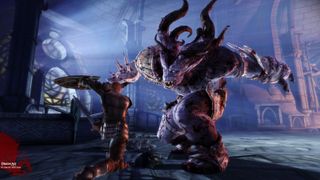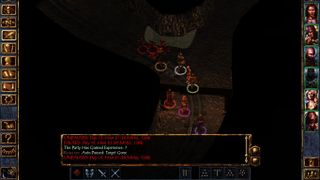Why I hate pausable real-time RPG combat

The big choices about who to side with, the gang of companions who open up the more you talk to them, the romances—so many of the things we think of as quintessential BioWare began in Baldur’s Gate 2. It seemed like BioWare had seen what Obsidian had achieved with the Infinity Engine in Planescape: Torment the year before and stepped up their game in response.
Pillars of Eternity feels like Obsidian returning the compliment, picking up the ball and throwing it back. It’s a blend of the two studio’s house styles, with deep philosophical questions and the consequences of past lives making it a close cousin to Planescape, and the lack of romance options an Obsidian trademark. Meanwhile, Caed Nua is their take on the strongholds of Baldur’s Gate 2 and navigating the factions of Defiance Bay resembles the Athkatla section of that game.
But of all the things to keep from the games that inspired it, pausable real-time combat is the most baffling. Planescape seemed to go out of its way to have as few as possible of those moments where the story grinds to a halt while the Dungeon Master puts everyone’s miniature on the board and says ‘roll for initiative.’ Even when the Infinity Engine was new, its pausable real-time combat felt like a clunky compromise necessitated by the peculiarities of the era.
They were strange days
Timothy Cain, producer, lead programmer, and one of the designers of the original Fallout, gave a talk at GDC in 2012, a post-mortem of that classic, turn-based RPG. Halfway through that talk he paused, queued up the next slide and said the word ‘Diablo’ with a sigh. "Fun game," he went on to clarify, "lots of fun." And then the bitterness crept into his voice: "Thorn in my side."
Saying Diablo streamlined the RPG is like saying bullets streamlined arrows. It was fast and frantic and so pure it was almost grotesque. Sometimes, Diablo said, you just want to click skeletons to bits and take their stuff. This was the late 1990s, and real-time strategy games had already beaten up their turn-based ancestors and taken their lunch money, presumably while they were waiting for someone to click the End Turn button so they could retaliate. It seemed obvious at the time that Blizzard was going to do the same thing to turn-based RPGs, making them seem clunky and old-fashioned—at least in the eyes of people trying to market them.

"I had to go to lots of meetings with marketing and administration," Timothy Cain goes on to say in his GDC talk. "They wanted Fallout to be multiplayer and real-time." But Cain stood his ground. Fallout had already been in development for over two years, and he argued the cost of changing it wouldn’t be worthwhile. In the end they let him make his game the way he wanted to, and it’s better for it. The blackly comic tone of Fallout is well-served by gruesome text descriptions of each called shot’s results, whether to the eyes or the crotch, and there’s a rising tension you only experience when one by one your characters fail to take down a Super Mutant spinning up a chaingun and you’re forced to end the turn and pray you survive once the bullets start flying.
In September of 1998 Interplay brought out Fallout 2, with the same turn-based combat system. And then three months later they published Bioware’s Baldur’s Gate and ushered in the era of pausable real-time combat. Baldur’s Gate was no Diablo, and giving you control of a party of up to six heroes rather than a single protagonist meant a fully real-time system wouldn’t have been feasible. To compete with the hot new thing in RPGs the designers looked back, drawing on 1992’s Darklands for inspiration.
PC Gamer Newsletter
Sign up to get the best content of the week, and great gaming deals, as picked by the editors.
In Darklands you controlled a party of four in 15th century Germany, but it was a version of Germany in which the beliefs of the time were true. Dragons were real, and praying to saints could result in miracles. High fantasy games cross the street to walk on the other side when they see realism heading toward them, but the relatively low fantasy Darklands was at least a nodding acquaintance with the concept, and in theory real-time combat is the more realistic option.
The path of most resistance
While fighting gangs of thieves in Darklands’ streets you pressed spacebar to pause and then gave orders individually, telling your alchemist to fire his crossbow while the other characters formed a defensive line and then tried to envelop the enemy. In practice every battle descended into a chaotic scrum. Characters sent round the back to flank would get distracted and attack the first enemy they saw, while Gretchen the Holy would bump into one of her allies then turn around and head off in entirely the wrong direction through the side streets of Hamburg.
Still, that was only 1992 and early days. Surely, six years later—especially given the hectic rate of technological advancement that characterized game design in the 1990s—things would have improved significantly. But, three levels deep in the guts of the Nashkel Mines in Baldur’s Gate, Minsc the ranger was meandering into the darkness because he’d collided with Branwen the cleric in the narrow tunnels, inevitably blundering into a trap.

Bad pathfinding isn’t unique to games with pausable real-time combat, but it is exacerbated by it. It’s easier to ignore when short-lived enemies are the only ones who get stuck on crates, or when you’re controlling just the one character who sometimes gets confused and tries to take the long way round. When it’s your entire team turning into bumbling lummoxes the moment you press spacebar to send them into action it’s impossible to ignore. They stop feeling like they’re under your control: the game may as well be playing itself.
Pathfinding isn’t the only problem pausable real-time combat highlights. Behind the scenes, most of these games are still giving characters turns. Even if those turns are overlapping and often simultaneous, there’s still a noticeable pause between actions. In Knights of the Old Republic your Jedi will leap into the fray, flipping through the air and landing among enemies with lightsabers spinning like blenders of death. Then they stop and just sort of bob on the spot for a few seconds, like a Mortal Kombat fighter waiting for the next round to start. Gun-toting characters behave just as weirdly, snapping off a few shots then standing out in the open until an invisible hourglass fills up and they can act again.
In turn-based combat your imagination overrides the abstractions. You know that while one of your XCOM squaddies is racing for cover the enemy isn’t holding their fire and the rest of the squad aren’t patiently waiting their turn; in your head the firefight never stops. But Knights of the Old Republic’s sudden switches between slick attack animations and characters awkwardly bouncing on the spot like they’re holding drinks on the edges of the dancefloor is much harder for the imagination to paper over. It just looks silly.
To minimize the amount of time characters in Dragon Age bob like idiots when it’s not their turn the attack animations are extended into dizzying combos so that even your wizard’s default attack involves whirling a staff and whizzing off multiple blasts while striking dramatic poses. To reduce the amount of pathfinding calculations by the second game the rogue’s backstab ability somehow involved teleporting behind enemies so you didn’t actually have to walk round them. In Dragon Age: Inquisition the amount of whizz-bang special effects hurtling across the screen every time an ability is used can almost distract you from what’s going on, though the longer you play the more the clunkiness behind the curtain becomes apparent.

By contrast the Mass Effect games remove those hidden turns, giving you the responsiveness of an actual real-time game. When you look down the scope of your M-98 Widow Anti-Material Rifle, take a breath, and then place a round in the head of an advancing Collector, you’re doing it while the battle smoothly carries on around you. When you do pause to give orders they’re carried out instantly as well, your squadmates launching Incinerate or Singularity in devastating synchronization. By Mass Effect 3 the system was so polished they could scrap the ability to pause altogether for the multiplayer mode and still have something that was surprisingly fun. The multiplayer mode of Dragon Age: Inquisition didn’t hold up nearly as well.
Pillars of Eternity makes its own tweaks, of course. Its engagement mechanic punishes running around like a headless chicken, there’s an option to play in slow motion rather than stuttering stop-start, and of course the spell effects look a lot more impressive (although that means if you pause at the wrong time half your party will be obscured by bursts of light and flame). But it still has characters who get confused by having to walk all the way round an ogre to get somewhere, or wait until an oil slick has been summoned to run right through it, or blithely stroll straight into traps they’ve already detected. Wasteland 2, another Kickstarter-funded resurrection of old-fashioned RPGs, modernized the combat of the early Fallout games with a healthy dose of XCOM, and was better for it. But while Pillars of Eternity preserves a lot of things about old games that are worth keeping, its preservation of pausable real-time combat feels like a step in the wrong direction—one that leads back into the darkness of the Nashkel Mines, where I never want to place foot again.
But if anyone finds Minsc the ranger in there, say ‘hi’ for me.

Jody's first computer was a Commodore 64, so he remembers having to use a code wheel to play Pool of Radiance. A former music journalist who interviewed everyone from Giorgio Moroder to Trent Reznor, Jody also co-hosted Australia's first radio show about videogames, Zed Games. He's written for Rock Paper Shotgun, The Big Issue, GamesRadar, Zam, Glixel, Five Out of Ten Magazine, and Playboy.com, whose cheques with the bunny logo made for fun conversations at the bank. Jody's first article for PC Gamer was about the audio of Alien Isolation, published in 2015, and since then he's written about why Silent Hill belongs on PC, why Recettear: An Item Shop's Tale is the best fantasy shopkeeper tycoon game, and how weird Lost Ark can get. Jody edited PC Gamer Indie from 2017 to 2018, and he eventually lived up to his promise to play every Warhammer videogame.
Most Popular

